
AMERICAN WHITE PELICAN, Pelicans erythrorhynchos, Pelicano Blanco Americano(Spanish), Sak p’onto’ (Mayan)
Part one introduced the American White Pelican, a massive bird weighing up to 30 pounds with a 9.5-foot wingspan, one of the heaviest flying birds in North America and twice as heavy as its Brown Pelican cousin. I had the opportunity to watch a migratory flock of 300 in Florida stop to forage in a shallow lake and to rest and loaf on a sand bar. Prior to this, I’d observed a few white pelicans at Chelem, Celestun, and Progreso, Yucatan.



Those pelican pouches, sushi super scoopers, fascinated me. But then I noticed holes in them caused by fish fin spines, fish hooks, and perhaps pelicans ripping holes with their sharp hooked upper bill tips while competing for food. However, I discovered in one of my pictures that the elasticity of the pouch can form a pouch within the pouch to hold a fish! But pelican pouches and bills have other functions than just capture prey. One unbelievable use is that the pelican breathes through its mouth due to its dysfunctional nostrils!
PHOTO 5. Punctured pouch of American White Pelican

PHOTO 7. White pelican scoops up fish into another “pouch” within the pouch due to its elasticity
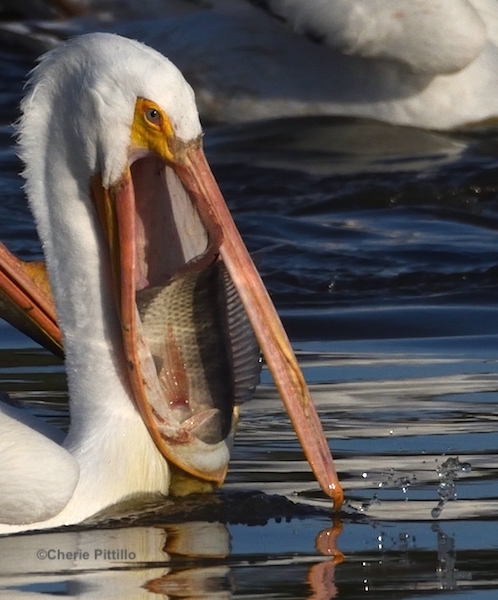
Then during the breeding season, the color of the pouch and bill intensifies. After an absence from the nest, the returning mate inflates and displays the brightly colored pouch from the side while offering soft grunts. This behavior seems necessary for mate recognition.
Also, both sexes grow a vertical epidermal plate or “horn” on their upper bill, about 1-3 inches in height. Scientists are unsure about the breeding horn. (Duh, it’s the breeding season!) Meanwhile, courting males may stretch out the pouch and flap it while also bill clapping. (Some sources state no bill clapping exists.) After the eggs are laid, the horn drops off. In addition, a chick can put its head inside an open pouch to “fish” for partly digested food, its own buffet.

Of the eight species of pelicans, only the American White Pelican produces the horn, maybe as a sexual accessory or part of mate recognition. In an interesting behavior, it seems to be a target to jab at by other pelicans during nesting season. However, after it falls off, aggressive pelicans will still jab at the area where it was. Perhaps this behavior reduces the chance for injury.
Another pouch role happens when the pelican faces away from the sun and flutters the pouch to cool down. Many blood vessels are within the pouch and flapping allows heat to escape. Energy-wise this technique is more efficient than panting.
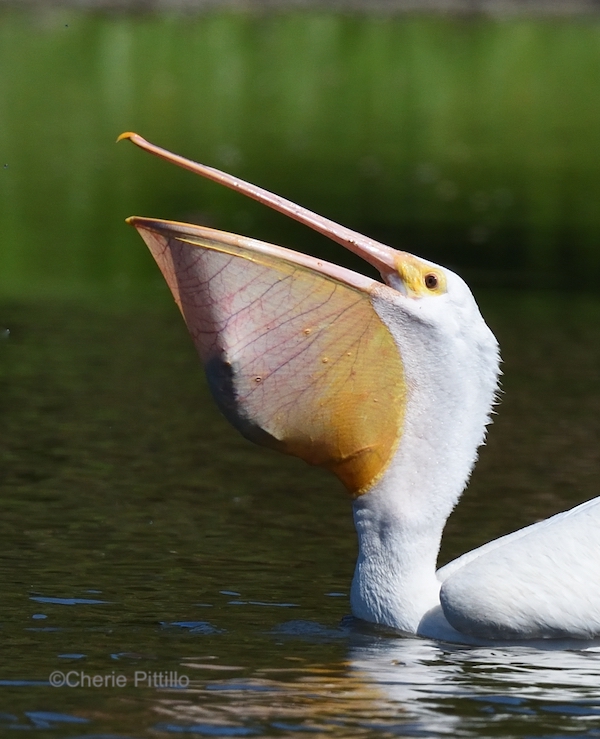
Here’s an interesting fact: pelicans perform pouch exercises to retain elasticity. They may throw their head back with the bill open and stretch or tuck their head and sack down or turn the elastic-like scoop inside out.
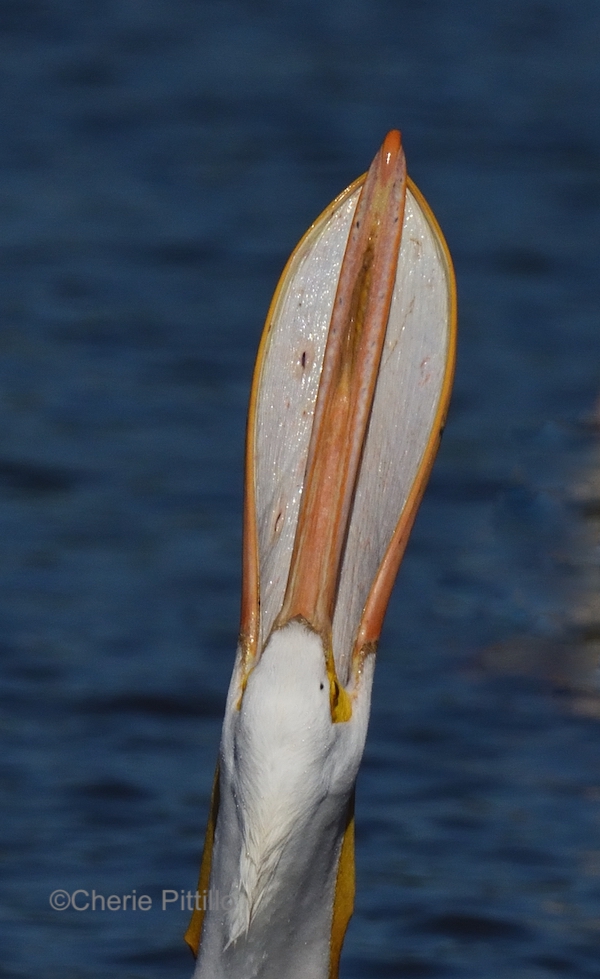
I would be remiss if I didn’t include how white pelicans forage and how they spend about one third of their time, which is preen.
While two hundred American White Pelicans loafed on a small sand bank resting and preening, others swam in several separate flocks to hunt for mainly fish. Sometimes the pelican fished alone or with three or four in a group, or a large flock. Of course prey capture rates were better with more pelicans working together.
These rafts of pelicans have different names such as pod, brief, or scoop, but my favorite is squadron, because they looked like they were on silent patrol. While the Brown Pelican plunge dives, the white pelican doesn’t and can fish cooperatively. Most references state the pelicans form a line, a semi-circle, or a circle to herd fish into the shallows or close to shore.


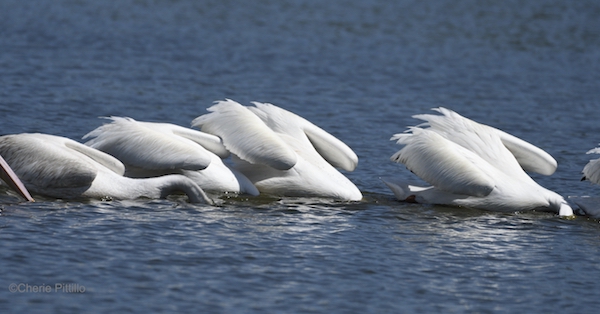
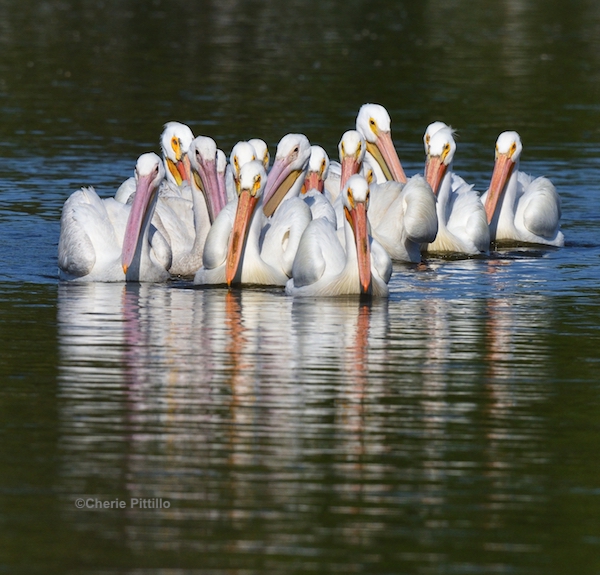

Many times I saw “mirroring” where two large flocks slowly swam toward each other, merge10d, and thrusted their bills into the water at the same time. Sometimes their wings were flared slightly open which may have given them room to feed in that crowd or to push fish forward. I don’t understand how they dip their bills, expand their pouch to hold three gallons of water and their prey in such closeness to each other. How amazing that they may synchronize their herding and gathering of prey.
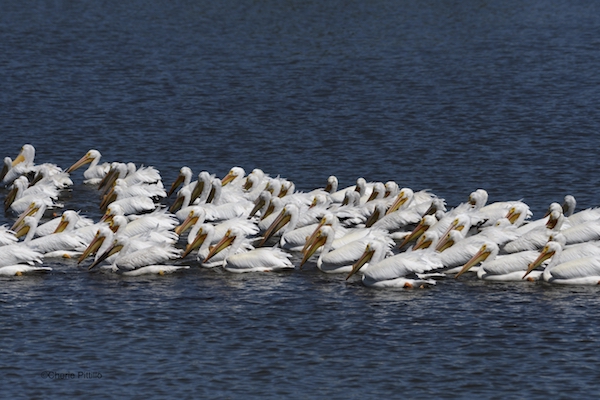

My astonishment arose from these squadrons silently swimming or feeding. I heard calls from ospreys, storks, and egrets but not the pelicans. (Typically adults are silent but chicks are noisy nestlings.) How could that many birds be soundless? Time seemed in slow motion like a peaceful, quiet gathering whether they were swimming, feeding, preening, or resting. I realized many onlookers on shore with me were mesmerized with these pelican processions. We were quiet too as if we were afraid to disturb the tranquility.
The only time I heard any noise was from pelican wingbeats with take-off or landing on the water. They could literally ski into where the crowd was feeding. I also noticed how low in the water these heavy birds landed and then seemed to bounce up to float high on the water. Many subcutaneous air sacs in the chest act as a life preserver which increases their buoyancy by over 60%. Look at the wake in the image below!
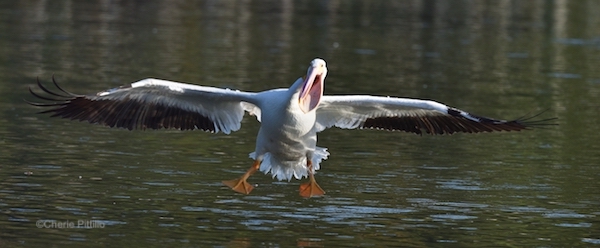
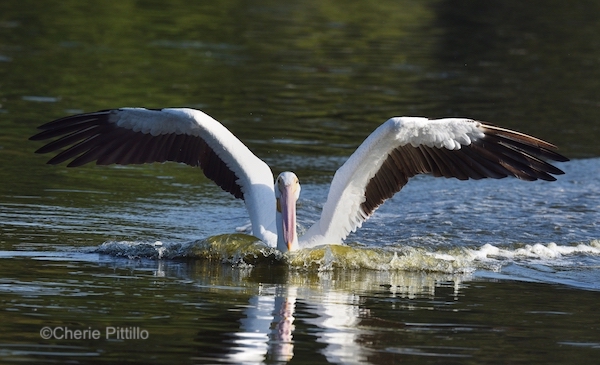
And then pelicans preen about 29% of their time at their lounging area to keep those feathers oiled in great condition and in place. That hooked bill tip works well as a great comb.

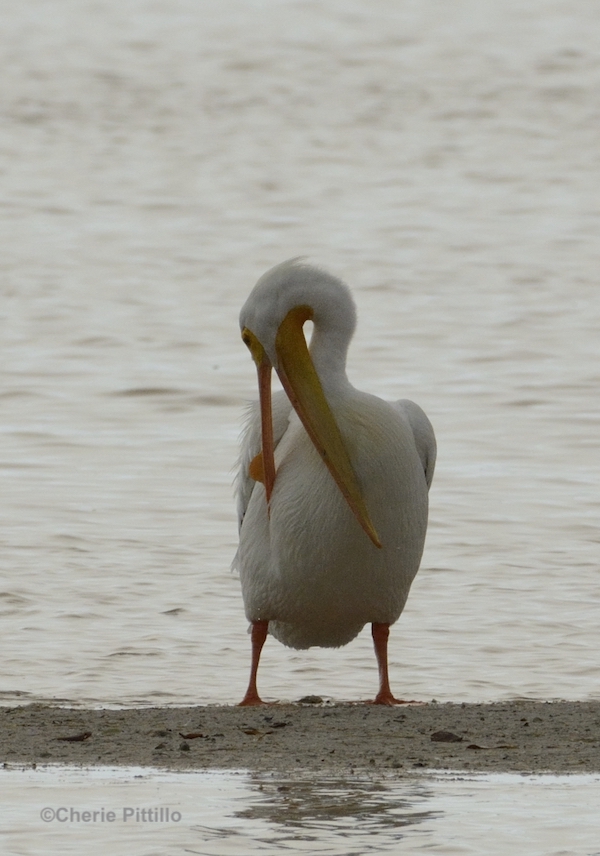
Since I mentioned how silent they were, I do want to include that chicks pip before hatching to communicate whether they are hot or cold. Both parents incubate the eggs by holding the eggs under the webs of their feet in a shallow nest. When parents raise up to preen, the eggs aren’t exposed to the air. When the chicks pip, parents can then adjust their webbed feet. Once hatched, the chicks grunt, squeak, and bark.
SOUND LINK of CHICKS: https://www.xeno-canto.org/36291
Immature birds are mostly white but have dusky feathers on their heads, necks, and backs, and lighter bills and legs. After breeding, the adults lose their bright pouch colors and develop gray head feathers.

How fortunate to see this large flock that only stops every two or three years on its migration to breeding grounds in inland lakes and parries in the United States and Canada. And I’m including an image of fish recycling I don’t usually see.

SCOOP UP TIME FOR NATURE TO SOOTHE YOUR SOUL!
DISCLAIMER: REFERENCES DO NOT ALWAYS AGREE ON INFORMATION:
Sal a Pajarear Yucatán, Bird & Reserves of the Yucatan Peninsula, A Guide to the Birds of Mexico and North Central America, The Sibley Guide to Birds, Lives of North American Birds,
North American Birds Vol 65 #3 (2011), Birds of the Yucatan Peninsula in Mexico
Knopf, F. L. and R. M. Evans (2020). American White Pelican (Pelecanus erythrorhynchos), version 1.0. In Birds of the World (A. F. Poole, Editor). Cornell Lab of Ornithology, Ithaca, NY, US
https://www.allaboutbirds.org/guide/American_White_Pelican/
http://pcwd.info/wp-content/uploads/2015/12/Pelicans.pdf
https://sora.unm.edu/sites/default/files/journals/condor/v066n01/p0003-p0023.pdf
https://www.naturalhistorymag.com/htmlsite/editors_pick/1976_12_pick.html
https://digitalcommons.uri.edu/cgi/viewcontent.cgi?article=1716&context=oa_diss
https://birdsoftheworld.org/bow/species/amwpel/cur/introduction
https://animaldiversity.org/accounts/Pelecanus_erythrorhynchos/
Andrew Spencer, XC36291. Accessible at www.xeno-canto.org/36291.
Cherie Pittillo, “nature inspired,” photographer and author, explores nature everywhere she goes. She’s identified 56 bird species in her Merida, Yucatan backyard view. Her monthly column features anecdotes about birding in Merida, Yucatan and also wildlife beyond the Yucatan.
Contact: [email protected] All rights reserved, ©Cherie Pittillo
